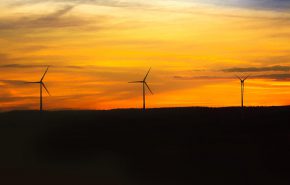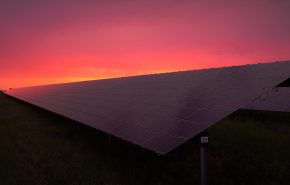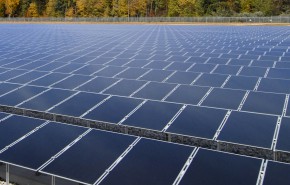Green hydrogen is a carbon emission-free, multipurpose fuel that is created using power produced by a renewable energy source. Projected to serve a $1.4 trillion worldwide market by 2050, green hydrogen production offers renewable energy providers the opportunity to diversify their offerings and optimize their renewable energy investment to meet this major emerging market.
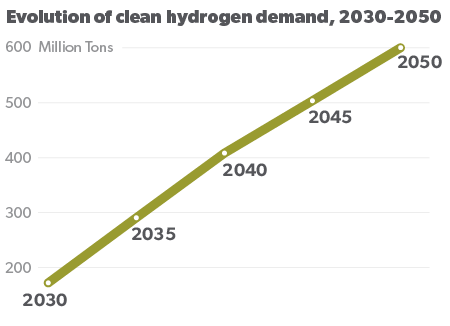
Powering a Cleaner Future
“To be considered green hydrogen, the fuel has to be produced using electricity generated by a source that produces zero greenhouse gas emissions, like a wind farm or solar array,” said Rachel Stukenborg, Senior Technical Specialist with GAI’s Renewable Energy group. Green hydrogen is among several energy strategies seen to help the U.S. achieve its net zero greenhouse gas emissions commitment as part of a multinational agreement to reduce emissions to zero by the year 2050.
Green hydrogen is made from simple water using a process called electrolysis. In this process, an electrolyser unit powered by electricity generated by a renewable energy source separates water into its hydrogen and oxygen components, producing hydrogen gas that can be used as fuel and oxygen gas as a by-product.
“Green hydrogen is extremely attractive as it offers a valuable solution to the renewable energy storage and portability challenge,” said Enrique Bazán-Arias, PE, EMBA, Engineering Manager with GAI’s Renewable Energy group. “It is a clean way to power industries that are considered difficult to decarbonize, like shipping, agriculture, aviation, transportation, ammonia production, steel refining, and other energy-intensive industries.”
Green hydrogen production facilities may be developed and strategically sited near a predetermined end user. Examples of green hydrogen production development in the U.S. during this emerging phase include a project currently under construction by CF Industries that is being integrated directly into an existing manufacturing plant’s ammonia synthesis loops; an initiative by Green Hydrogen International to develop a green hydrogen, wind, and solar hybrid plant that will be used to produce clean rocket fuel for SpaceX; and a green hydrogen plant under development by Air Products that is poised to sell green hydrogen to the mobility market in California and other west coast states.
Seeding Green Hydrogen Growth
While green hydrogen production in the U.S. is today in its early stages, significant and rapid growth is expected as potential users increasingly seek to cut down emissions levels to meet net zero goals. The U.S. government is acting to advance green hydrogen as a viable energy option through a range of programs and incentives aimed to stimulate production, spur research and development, and reduce green hydrogen production costs.
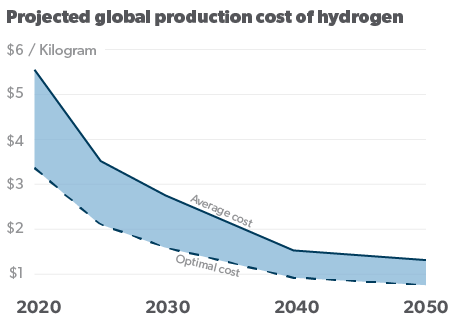
“The Inflation Reduction Act introduced clean hydrogen production tax credits, which is a 10-year incentive that offers a tax credit of up to $3 per kilogram of green hydrogen produced,” said Stukenborg. “There’s also the Hydrogen Shot initiative implemented by the U.S. Department of Energy through the American Jobs Plan, which aims to reduce the cost of hydrogen production by 80% by 2031.”
Additionally, the Bipartisan Infrastructure Law allocates $1 billion to a Clean Hydrogen Electrolysis Program aimed to lower green hydrogen production cost, and $8 billion for the development of Regional Clean Hydrogen Hubs that seek to create regional networks of local green hydrogen producers, consumers, and connective infrastructure to help speed and spread green hydrogen availability and adoption.
“Understanding and gaining full advantage of government programs, regulations, and funding opportunities can present a substantial challenge,” said Bazán-Arias. “GAI’s Renewable Energy group includes experienced professionals whose primary specialization is helping clients successfully meet their regulatory obligations and funding and incentive goals during development, permitting, and project execution.”
GAI’s Renewable Energy group includes experienced professionals whose primary specialization is helping clients successfully meet their regulatory obligations and funding and incentive goals during development, permitting, and project execution.
A Cross-Functional Team to Meet Green Hydrogen Goals
In addition to help navigating the funding and regulatory landscape, GAI clients seeking to position themselves to serve the green hydrogen market benefit from the firm’s comprehensive suite of engineering and environmental services that come together to provide a range of project solutions.
“Like many of the wind and solar energy projects that we have helped clients successfully deploy in the past, developing a green hydrogen facility draws upon several of the diverse and cross-functional engineering services that we provide, including geotechnical, siting, structural, hydrological, regulatory, survey, environmental, mechanical and electrical, and more,” said Bazán-Arias. “This provides value for our clients as it reduces the need to employ multiple consulting firms and sets up a flexible, responsive, and efficient working environment to the benefit of the clients’ budget and timeline.”
“It’s exciting to work in the renewables space at the start of what promises to be a major development in the evolution of clean energy,” said Stukenborg. “We are working toward something new and beneficial, and our clients and their projects gain from the enthusiasm and commitment that GAI’s team brings to help make a cleaner, brighter future a reality.
Contact Enrique Bazán-Arias, 412.399.5465, or Rachel Stukensborg,804.340.7053, for more information about GAI’s renewable energy services —message GAI and start the conversation about how our multidiscipline professionals can meet your unique project needs.
![]() Enrique Bazán-Arias, PE, EMBA specializes in civil engineering including civil and structural design, site characterization, forensic analysis, power generation facilities, foundations and slope stability, and more. Since 2015 he has focused on renewable energy projects, in particular battery, solar, and wind. He has managed dozens of utility-scale projects ranging from origination and preliminary design through construction and owner’s engineer review.
Enrique Bazán-Arias, PE, EMBA specializes in civil engineering including civil and structural design, site characterization, forensic analysis, power generation facilities, foundations and slope stability, and more. Since 2015 he has focused on renewable energy projects, in particular battery, solar, and wind. He has managed dozens of utility-scale projects ranging from origination and preliminary design through construction and owner’s engineer review.
![]() Rachel Stukenborg advances renewable energy initiatives by supporting preliminary site design and energy production modeling for solar energy and energy storage projects. She performs engineering calculations, prepares project drawings, generates contract documents and specifications, and completes engineering reports, as well as providing supplying technical support for contractors during project construction.
Rachel Stukenborg advances renewable energy initiatives by supporting preliminary site design and energy production modeling for solar energy and energy storage projects. She performs engineering calculations, prepares project drawings, generates contract documents and specifications, and completes engineering reports, as well as providing supplying technical support for contractors during project construction.
